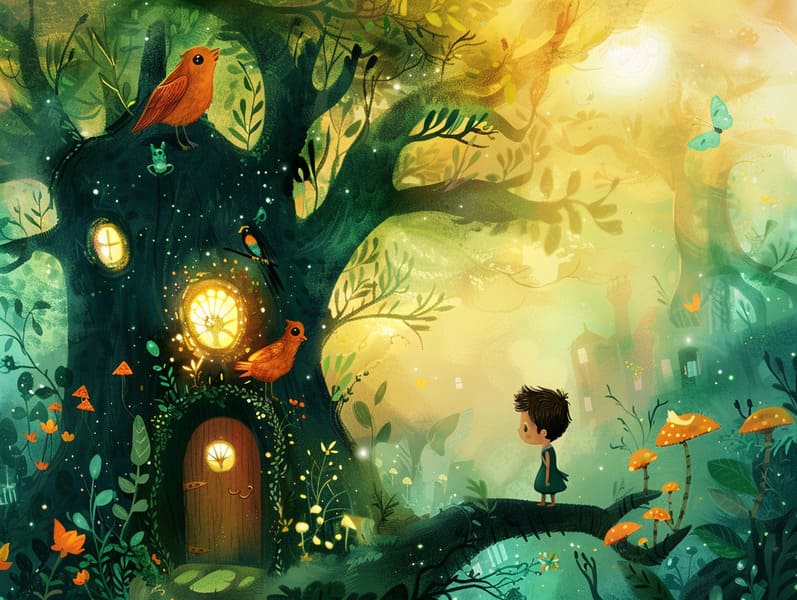
Best fairy tales have old origins. These tales have been recounted from one generation to the next well before they were ever published. They were born from a variety of backgrounds, including African traditions. They were initially shared among adults, often carrying themes and messages aligned with the societal norms and beliefs of the time.
The famous Grimm duo, Jacob and Wilhelm, were among the first to collect many of these beloved narratives. Their collection, "Grimm's Fairy Stories," included tales like "Cinderella," "Hansel and Gretel," and "Little Snow White," which have since become hallmarks in the world of famous fairy tales. Similarly, Hans Christian Andersen's charming stories, such as "The Mermaid's Tale," and "The Story of the Ugly Duckling," have touched hearts worldwide, ensuring their place in the pantheon of beloved fairy tales.
Though they are centuries old, fairy tales remain as meaningful as ever, especially as nighttime stories for kids. These whimsical stories are now available in diverse formats, including artistically illustrated books, fantastical animations, and internet fairy tales.
Their continued relevance can be ascribed to several whimsical characteristics:
Key Lessons: Traditional fairy tales often provide important moral lessons. Narratives like "The Shepherd Boy and the Wolf" teach the importance of honesty, while "The Tortoise and the Hare" stress the virtues of tenacity and humbleness. These narratives offer young ones clear distinctions between moral and immoral, shaping their moral compass in a kind yet deep way.
Empathy and Awareness: Timeless fairy tales frequently involve beings facing challenges and struggles, urging young readers to sympathize with their struggles and celebrate their triumphs. For instance, "Beauty and Her Beast" shows us the merit of seeing inner beauty to appreciate the inner spirit of a being, cultivating understanding and recognition.
Cultural Comprehension: Many fairy tales are rooted in the cultural contexts from which they sprang. Delving into these narratives can provide captivating looks into different cultures, building a sense of global understanding and comprehension.
Imagination and Creativity: The fantasy-filled elements in classic fairy tales—wizardry and magic—ignite children’s innovative ideas. These stories bring readers to mythical realms, stimulating innovative ideas and a sense of magic that persists a lifetime.
Old fairy tales are not only whimsical but also teaching. They work as captivating tools in strengthening various mind and heart abilities in children. When old fairy tales are spoken out loud, they strengthen speaking abilities by showing new language and detailed sentence structures. This practice also improves auditory skills and attention span, as children remain attentive, anxious to see what happens next.
Furthermore, contemplating the themes and characters of ancient fairy tales can improve intellectual skills and evaluative skills. The young are shown to identify patterns, predict happenings, and realize cause and effect. These conversations also contribute to young ones utter their thoughts and feelings, promoting their emotional intelligence.
In today’s technological age, the accessibility of web-based fairy tales has made these narratives more reachable than ever. Digital sites and digital apps offer ample collections of timeless fairy tales that can be read or played anytime, anywhere. Fairy tales told out loud are particularly widespread, extending an fascinating method for children to immerse in these magical stories. Sound books and spoken videos carry characters and settings to life, often complemented by delightful soundtracks and tunes that amplify the narrative journey.
The timeless allure of old fairy tales lies in their ability to transform to present eras while keeping their central values. Contemporary renditions of these narratives often spotlight more representative characters and modern settings, making them meaningful to today’s audience. However, the main ideas of daring, compassion, and impartiality remain unchanged, continuing to strike a chord with young readers of all ages.
Timeless fairy tales also offer a sense of contentment and knownness. They supply a structured narrative with a obvious beginning, middle, and end, often closing with the wrap-up of conflicts and the triumph of right over wrong. This uniformity can be encouraging for children, bringing a sense of sturdiness in an constantly changing world.
Timeless fairy tales continue to spellbind and teach new generations, maintaining their grandeur and value in modern society. As children's night stories, they confer a perfect blend of allure and teaching, cultivating moral values, empathy, and creativity. The existence of digital fairy tales and the well-liked nature of fairy tales narrated warrant that these classic fairy tales remain attainable to new generations.
By more info retaining and passing on these tales, we continue to venerate the rich tapestry of inventiveness and cultural heritage. Whether you are viewing a artistically illustrated book, enjoying a online library, or playing an spoken story, the appeal of timeless fairy tales is always within reach. These tales reveal of the consistent strength of narratives and its ability to draw us together across centuries and lands.
Even if you are experiencing a richly illustrated book, delving into a digital library, or listening to an audiobook, the beauty of famous fairy tales is always within reach.
These fairy tales highlight of the invariable essence of tales and its ability to gather us across epochs and places, weaving a spell that charms and informs alike.